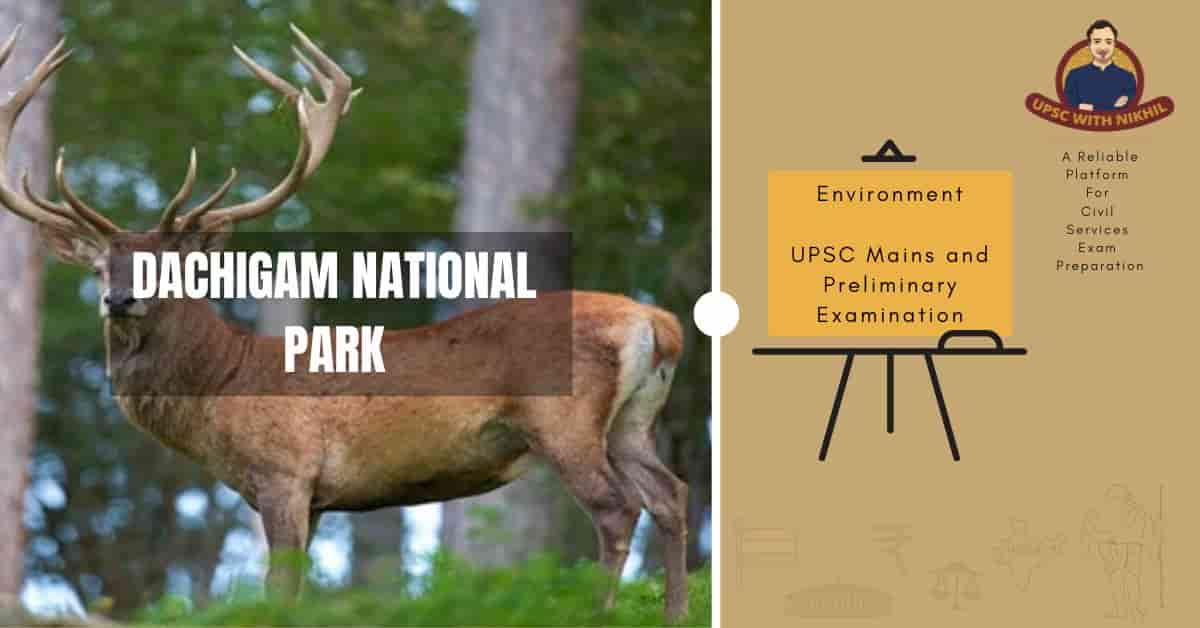Dachigam National Park
Dachigam national park is located in Jammu and Kashmir. It is at a distance of 22 km from Srinagar. It was declared a protected area in 1910. In the year 1981 it was declared as National Park.
Dachigam means “10 villages”. The name symbolize the 10 villages that were relocated from the area for the formation of Dachigam national park. The park is famous for its diverse wildlife, beautiful evergreen and coniferous forests and bird species.
In the time of British Indian the park was specially reserved for the hunting purpose of Maharaja of Kashmir. Then in 1910 it was declared as a protected area to conserve the forest area, wildlife and water source. The primary goal was to ensure the supply of clean drinking water to the people of Srinagar.
FACTS ABOUT DACHIGAM NATIONAL PARK
• Dachigam national park falls in the Zabarwan range in the western Himalayas.
• In the year 1951 it was declared as the Wildlife Sanctuary.
• The national park is situated at an average height of 2990 meters above sea level.
• It covers total area of 141 sq. km.
• The park is divided into lower Dachigam and upper Dachigam.
• It is famous for Himalayan moist temperate evergreen forest.
• The forest also consists of moist deciduous trees, shrubs, deodar, pine and oak trees.
• The mountain sides of the national park are covered in Coniferous forest tress that has broad leaves.
• Dachigam national park is known as the home of Hangul. It has the last surviving population of Hangul in the world.
• From spring to autumn, Himalayan Black Bears can be seen in the lower reaches before hibernating in the winter.
• Long-tailed Marmots are most visible in the upper reaches during the summer, while Mouse Hare are active all year.
• The National Park covers nearly half of the catchment area of the famous Dal Lake and continues to play an important role in supplying clean drinking water to Srinagar residents.
• The leopard, snow leopard, black bear, brown bear, jungle cat, Himalayan marmot, musk deer, serow, and red fox are all important wildlife species in this park.
• Pheasant's koklas and monals, bulbul, minivet, barred vulture, and golden eagles are common species among the birds that can be found in the park.
• The topography of Dachigam National Park is diverse, with thick woods, steep rocky ridges, gentle grassy slopes, and deep gullies.
• The National Park covers nearly half of the catchment area of the famous Dal Lake and continues to play an important role in supplying clean drinking water to Srinagar residents.
• Marsar Lake is surrounded by 4,000-meter-high ridges and is fed by perennial springs as well as streams and rivulets flowing down the ridges.
• The Daghwan stream flows into the park from the Marsar Lake, bringing clean, fresh water with it.
LATEST NEWS ON WILDLIFE SPECIES IN DACHIGAM NATIONAL PARK
• The Hangul (or Kashmiri Stag) population monitoring project has revealed an alarming decline in the hangul population's fawn-to-stag and stag-to-stag ratios in Kashmir.
• The Department of Wildlife Protection, Jammu & Kashmir (DWLP) collaborated with the Wildlife Institute of India to conduct the exercise (WII).
• Hind is a female deer over three years old, and her counterpart, the mature male, is called a stag. Fawn is a young deer in its first year, and Hind is a female deer over three years old.
• The male-female and fawn-female ratios are critical for deer population management and conservation.
• Although hangul is only found in the Dachigam National park near Srinagar, a small population has been spotted in the Overa-Aru Wildlife Sanctuary in south Kashmir.
• The Kashmir stag is India's only surviving red deer species and the state animal of Jammu and Kashmir.
Dominant flora
• Wild Cherry
• Pear
• Plum
• Peach
• Apple
• Apricot
• Walnut
• Chestnut
• Oak
• Willow
• Poplar
• Chinar
• Birch
• Pine
• Elm
• Chestnut
• Poplars
Dominant fauna
Mammals –
• Kashmiri Stag
• Musk Deer
• leopards
• Himalayan Gray Langurs
• Leopard Cats
• Himalayan black bear
• Jackals
• Hill Fox
• Himalayan Weasel
• Yellow-throated Martens
• Jungle Cat
• Long Tailed Marmots
• Himalayan Brown Bear
• The Otter
• Yellow-throated Marten
• Jungle-cat
• Himalayan Fox
• Serow
Birds –
• Monal Pheasant
• Crimson Tragopan
• Golden Eagle
• Bearded Vulture
• Griffon Vulture
• Lammergeier Vulture
• Blood Pheasant
• Cinnamon Sparrow
• Woodpeckers
• Himalayan Ruby throat
• Pygmy Owlet
• Babblers
• Orange Bullfinch
• Golden Oriole
• Black Bulbul
• Koklass Pheasant
• Peregrine Falcon
• Paradise Flycatcher
• Western Yellow-Billed Blue Magpie
• Golden Oriole
• Grey Heron



